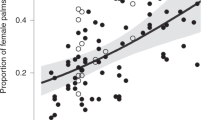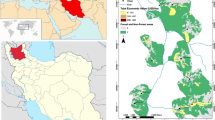New data shows that edible fruit and nut production in Amazonian forests is substantially lower than most conservationists assume. Direct measures of production in Amazonian Peru show that two terra firma forest types produced significantly less edible fruit than an alluvial soil forest. Swamp forest produced more edible fruit than any other forest type measured. Palms produce 60% of edible fruit productivity, averaged over three forest types, but the most preferred palm fruits are difficult to harvest because they are borne too high for easy access by collectors. Forest fruit collection in Amazonia is less productive in the short-term than all other food-producing activities except for hunting and cattle ranching. Technological, social and political changes are essential so that sustainable but intrinsically low-yielding extractive activities like fruit collecting become more attractive to Amazonians.
Similar content being viewed by others
References
Abdoellah, O.S. and G.C., Marten (1986) The complementary roles of homegardens, upland fields, and rice fields for meeting nutritional needs in west Java. In Traditional Agriculture in Southeast Asia (G.C., Marten, ed.), pp. 358. Boulder, Colorado: Westview Press.
Alcorn, J. (1984) Huastec Mayan Ethnobotany, 1st edit. pp. 982. Austin, Texas: University of Texas Press.
Alencar, J., da, Crúz, R. Aniceto de Almeida and Fernandes, N.P. (1979) Fenología de especies florestais em floresta tropical úmida de terra firme na Amazonía central. Acta Amazonica 9, 163–98.
Allegretti, M.H. (1989) Extractive reserves: an alternative for reconciling development and environmental conservation in Amazonia. In Alternatives to Deforestation in Amazonia: towards sustainable development (A.B., Anderson ed.). New York: Columbia University Press.
Ashton, P., Givnish, T.J. and Appanah, S. (1988) Staggered flowering in the Dipterocarpaceae: new insights into floral induction and the evolution of mast fruiting in the aseasonal tropics. Amer. Natur. 132: 44–66.
Balick, M.J. and Mendelsohn, R. (1992) Assessing the economic value of traditional medicines from tropical rain forests. Conserv. Biol. 6, 128–30.
Berkes, F., Feeny, D., McCay, B.J. and Acheson, J.M. (1989) The benefits of the commons. Nature 340, 91–3.
Blicher-Mathiesen, U. and Balslev, H. (1990) Attalea colenda (Arecaceae), a potential lauric oil resource. Econ. Bot. 44, 360–8.
Bodmer, R., Penn, J., Fang, T.G. and Moya, L. (1990) Management programmes and protected areas: the case of the Reserva Comunal Tamshiyacu-Tahuayo, Peru. Parks 1, 21–5.
Browder, J.O. (1990) Extractive reserves will not save the tropics. BioSci. 40, 640.
Cannell, M.G.R. (1989) Food crop potential of tropical trees. Exper. Agric. 25, 313–26.
Cavalcante, P.B. (1972, 1974, 1977) Frutas comestiveis da Amazonía Vols I, II, III. Belem, Brazil: Museu Paraense Emilio Goeldi.
Clay, J. (1992) In Non-Wood Forest Products from Tropical Rainforests (M. Plotkin and L. Famolare, eds.) Conservation International, in press.
Clement, C.R. (1989) A center of crop genetic diversity in western Amazonia. BioSc. 39, 624–31.
Clement, C.R. (1990) Origin, domestication and genetic conservation of Amazonian fruit tree species. In Ethnobiology: Implications and Applications, proceedings of the first international congress of ethnobiology (D.A., Posey and W.L., Overal, eds) pp. 249–63. Belem, Brazil: Museu Paraense Emilio Goeldi.
Clement, C.R. and Mora Urpi, J.E. (1987) Pejibaye palm (Bactris gasipaes, Arecaceae): multi-use potential for the lowland humid tropics. Econ. Bot. 41, 302–11.
Coomes, O. (1991) Rain forest extraction, agroforestry and resource depletion: an environmental history from the northeastern Peruvian Amazon. Paper presented to the XVI International Congress of the Latin American Studies Association, April 6 1991, Washington, DC, USA.
Crúz, F.W., Purizaca, C.J. and Canal, A.Z. (1987) Castañales nativos del departamento de Madre de Dios. Instituto de Investigaciones de la Amazonía Peruana (IIAP) Serie: Investigaciones Técnicos, año 1, 1–40.
Denevan, W.M. (1976). The aboriginal population of Amazonia. In The Native population of the Americas in 1492 (W.M., denevan ed.) pp. 205–34. Madison, Wisconsin: University of Wisconsin Press.
Erwin, T. (1984) The Tambopata Reserved Zone, Madre de Dios, Peru: history and description of the reserve. Revista Peruana de Entomologia 271, 1–8.
Fearnside, P. (1987) Rethinking continuous cultivation in Amazonia. BioSc. 37, 209–14.
Fearnside, P. (1989) Extractive reserves in Brazilian Amazonia. BioSc. 39, 387–93.
Foresta, R.A. (1991) Amazon Conservation in the Age of Development: the Limits of Providence. pp. 366. Gainesville, Florida: University of Florida Press, Center for Latin American studies.
Foster, R.B. (1983) The seasonal rhythm of fruitfall on Barro Colorado Island. In The Ecology of a Tropical Forest (E.G., Leigh, A.S., Rand and D.M., Windsor, eds) pp. 151–72. Oxford: Oxford University Press.
Foster, R.B. (1985) Plant seasonality in the forests of Panama. In The Botany and Natural History of Panama (W.G., D'Arcy and M.D., Correa A. eds) pp. 255–62. St Louis, Missouri: Missouri Botanical Garden.
Gentry, A.H. (1988a) Changes in plant community diversity and floristic composition on environmental and geographical gradients. Ann. Miss. Bot. Gar. 75, 1–34.
Gentry, A.H. (1988b) Tree species richness of upper Amazonian forests. Proc. Nat. Acad. Sci. 85, 156–9.
Giraldo, L.E.U. (1987) Estudio preliminar de la fenología de la canangucha (Mauritia flexuosa L.f.). Colómbia Amazónica 2, 57–81.
Gleissman, S.R. (1984) Resource management in traditional tropical agroecosystems in Southeast Mexico. In Agricultural Sustainability in a Changing World Order (G.K., Douglass ed.) pp. 191–201. Boulder, Colorado: Westview Press.
Hardin, G. (1968) The tragedy of the commons. Science 162, 1243–8.
Hardin, G. and Baden, J. eds (1977) Managing the Commons, San Francisco, California: Freeman.
Hart, T.B. and Hart, J.A. (1986) The ecological basis of hunter-gatherer subsistence in African rain forests: the Mbuti of eastern Zaire. Human Ecol. 14, 29–55.
Hecht, S.B. (1990) Indigenous soil management in the Latin American tropics: neglected knowledge of native peoples. In Agro-ecology and Small Farm Development (M., Altieri and S., Hecht eds) pp. 151–8. Boca Raton, Florida: CRC Press.
Janzen, D. (1974) Blackwater rivers and mast fruiting. Biotropica 6, 69–103.
John, L. (1989) Amazonia: Olhos de Satelite. Sao Paulo, Brazil: Editoracao Publicacoes e Comunicacoes Ltda.
Jordan, C.F. (1990) An Amazonian Rainforest: the structure and function of a nutrient-stressed ecosystem and the impact of slash-and-burn agriculture. Paris: UNESCO.
Mackinnon, C.B. (1990) Will drugs die with the trees? Chemicalweek, March 28, 58–9.
May, P.H. (1991) Building institutions and markets for non-wood forest products from the Brazilian Amazon. Unasylva 165, 9–16.
Myers, N. (1984) The Primary Source: tropical forests and our future, London: Norton.
Myers, N. (1986) Forestland farming in western Amazonia: stable and sustainable. Forest Ecol. and Man. 15, 81–93.
Nations, J.D. and Nigh, R.B. (1980) The evolutionary potential of Lacandon Maya sustained-yield tropical forest agriculture. J. Anthropol. Res. 36, 1–30.
Normanha, E.S. (1970) General aspects of cassava root production in Brazil. In Proceedings of the Second International Symposium on Tropical Root Crops. Honolulu, Hawaii.
Padoch, C. (1988) Aguaje (Mauritia flexuosa L.f.) in the economy of Iquitos, Peru. Adv. Econ. Bot. 6, 214–24.
Peters, C.M., Gentry, A. and Mendelsohn, R. (1989a) Valuation of an Amazonian rainforest. Nature 339, 655–6.
Peters, C.M., Balick, M.J., Kahn, F. and Anderson, A.B. (1989b) Oligarchic forests of economic plants in Amazonia: utilization and conservation of an important tropical resource. Cons. Biol. 3, 341–9.
Peters, C.M. and Hammond, E.J. (1990) Fruits from the flooded forests of Peruvian Amazonia: yield estimates for natural populations of three promising species. Adv. Econ. Bot. 8, 159–76.
Phillips, O.L. (1990) Ethnobotany and ecology of an Amazonian anthelmintic. Econ. Bot. 44, 534–6.
Pinedo-Vasquez, M., Zarin, D., Jipp, P. and Chota-Inuma, J. (1990) Use-values of tree species in a communal forest reserve in northeast Peru. Cons. Biol. 4, 405–16.
Prance, G.T. (1978) Conservation problems in the Amazon Basin. In Earthcare: Global Protection of Natural Areas. Proceedings of the Fourteenth Biennial Wilderness Conference (E.A., Schofield ed.) pp. 191–207. Boulder, Colorado: Westview Press.
Prance, G.T., Balee, W., Boom, B. and Carneiro, R. (1987) Quantitative ethnobotany and the case for conservation in Amazonia. Cons. Biol. 1, 296–310.
Redford, K.H. and Robinson, J.G. (1991) Subsistence and commercial uses of wildlife. In Subsistence and Commercial Uses of Neotropical Wildlife (J.G., Robinson and K.H., Redford, eds) pp. 3–23. Chicago: University of Chicago Press.
Robinson, J.G. and Redford, K.H. (1991) Sustainable harvest of neotropical forest mammals. In Subsistence and Commercial Uses of Neotropical Wildlife (J.G., Robinson and K.H., Redford, eds) pp. 415–29. Chicago: University of Chicago Press.
Salo, J., Kalliola, R., Hakkinen, I., Makinen, Y., Niemela, P., Puhakka, M. and Coley, P.D. (1986) River dynamics and the diversity of Amazon lowland forest. Nature 322, 254–58.
Schmink, M. and Wood, C.H. (1987) The “political ecology” of Amazonia. In Lands at Risk in the Third World: local level perspectives. (P.D., Little, M.M., Horowitz and A.E., Nyerges, eds). Boulder, Colorado: Westview Press.
Schwartzman, S. and Allegretti, M.H. (1987) Extractive production in the Amazon and the rubber tappers' movement. Report to the Environmental Defense Fund, Washington, DC.
Sims, L.S. and Peterkin, B.B. (1987) Contributions of fruits and vegetables to human nutrition. In Horticulture and Human Health (B., Quebedeaux and F., Bliss, eds) pp. 9–17. Englewood Cliffs, New Jersey: Prentice-Hall.
Smith, N.J.H., Williams, J.T. and Plucknett, D.L. (1991) Conserving the tropical cornucopia. Environment 33, 7–32.
Smythe, N. (1970) Relation between fruiting season and seed dispersal in a neotropical forest. Amer. Natural. 104, 25–35.
Terborgh, J.T. (1983) Five New World Primates: a study in comparative ecology. Princeton, New Jersey: Princeton University Press.
Toledo, V.M., Batis, A.I. and Becerra, R. (1992) Products from the tropical rain forests of Mexico: an ethnoecological approach. In Non-Wood Forest Products from Tropical Rainforests (M. Plotkin and L. Famolare, eds). Conservation International (in press).
Uhl, C., Buschbacher, R. and Serrao, E.S. (1988) Abandoned pastures in eastern Amazonia, I. Patterns of plant succession. J. Ecol. 76, 663–81.
Vasquez, R. and Gentry, A.H. (1989) Use and misuse of forest-harvested fruits in the Iquitos area. Conserv. Biol. 3, 351–61.
Vickers, W.T. (1991) Hunting yields and game composition over ten years in an Amazon Indian territory. In Subsistence and Commercial Uses of Neotropical Wildlife (J.G., Robinson and K.H., Redford eds) pp. 53–81 Chicago: University of Chicago Press.
Walschburger, T. and Von, Hildebrand, P. (1988) Observaciones sobre la utilizacaión estacional del bosque húmedo tropical por los indígenas del Rio Miriti. Colóm. Amazón. 3, 51–74.
Author information
Authors and Affiliations
Rights and permissions
About this article
Cite this article
Phillips, O. The potential for harvesting fruits in tropical rainforests: new data from Amazonian Peru. Biodivers Conserv 2, 18–38 (1993). https://doi.org/10.1007/BF00055100
Received:
Accepted:
Issue Date:
DOI: https://doi.org/10.1007/BF00055100




